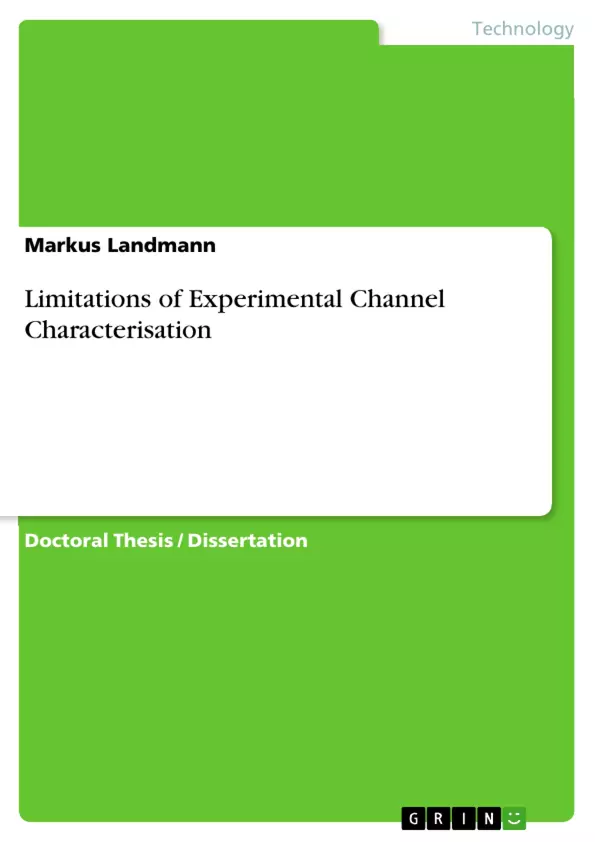This thesis deals with Experimental Channel Characterisation and its performance limits in real propagation environments. This includes recording of the multidimensional wideband channel
matrix by using a MIMO channel sounder and antenna arrays at both sides of the link. High-resolution parameter estimation is finally applied to characterise the channel in terms of DoD, DoA, TDoA, and complex polarimetric path weights. The quality of these estimates in “real world” scenarios is degraded by several impairments of the practical antenna arrays and the
measurement system used. The resulting estimation quality limits are investigated in detail by
simulations and measurements. The entire processing chain is analysed in terms of possible error sources. To this end, measurement system impairments, antenna array calibration errors as well as limitations of the radio channel model comprising two parts: specular like reflections (SC) and distributed diffuse scattering (DMC) applied by the high-resolution parameter estimation procedure are investigated. Moreover, consequences of using these results to deduce and parameterise geometry based channel models are demonstrated.
The contributions of this thesis are of interest for researchers dealing with high-resolution parameter estimation and channel modelling and can be summarised as follows:
• the efficient and accurate radiation pattern modelling of antenna arrays,
• the powerful performance evaluation framework for practical antenna arrays,
• the exposure of consequence of modelling errors on parameter estimation,
• and the demonstration of overall limitations of Experimental Channel Characterisation.
Inhaltsverzeichnis (Table of Contents)
- ABSTRACT
- KURZFASSUNG
- 1 Introduction
- 2 State of the Art
- 2.1 Introduction
- 2.2 Channel Sounding and Parameter Estimation
- 2.2.1 MIMO Channel Sounding
- 2.2.2 Channel Parameter Estimation Methods
- 2.3 Propagation Measurement Systems and Methods
- 2.3.1 Measurement Systems
- 2.3.2 Measurement Methods
- 2.4 Antennas
- 2.5 Channel Modelling
- 2.5.1 Geometry Based Channel Models
- 2.5.2 Stochastic Channel Models
- 2.6 Summary
- 3 System Model and Measurement Setup
- 3.1 System Model
- 3.1.1 Radio Channel Model
- 3.1.2 Measurement System Model
- 3.2 Measurement Setup
- 3.2.1 Hardware Components
- 3.2.2 Measurement Procedures
- 3.3 Summary
- 4 Antenna Array Calibration and Performance Evaluation
- 4.1 Introduction
- 4.2 Effective Aperture Distribution Function (EADF)
- 4.3 2D Array Calibration Procedure
- 4.3.1 Measurement Procedure
- 4.3.2 Phase Offset Compensation
- 4.4 Performance Evaluation Framework
- 4.5 Experimental Verification
- 4.6 Summary
- 5 Limitations of Experimental Channel Characterisation
- 5.1 Introduction
- 5.2 Model Mismatch
- 5.2.1 Antenna Array Related Model Mismatch
- 5.2.2 Measurement System Related Model Mismatch
- 5.3 Parameter Estimation in the Presence of Model Mismatch
- 5.4 Summary
- 6 Experimental Channel Characterisation in Complex Propagation Environments
- 6.1 Introduction
- 6.2 Ray-Tracing Simulations
- 6.3 Experimental Verification
- 6.4 Results and Discussion
- 6.5 Summary
- 7 Conclusion
- 8 Bibliography
Zielsetzung und Themenschwerpunkte (Objectives and Key Themes)
This dissertation investigates the limitations of Experimental Channel Characterisation in real propagation environments. This involves recording multidimensional wideband channel matrices using MIMO channel sounders and antenna arrays on both transmit and receive sides. The primary goal is to characterise the radio channel using parameters such as Direction of Departure (DoD), Direction of Arrival (DoA), Time Delay of Arrival (TDoA), and complex polarimetric path weights.The key themes explored in this work include:
- The impact of measurement system impairments and antenna array calibration errors on the accuracy of channel characterisation.
- The development of a powerful framework for performance evaluation of practical antenna arrays in terms of angular resolution limits.
- The investigation of model mismatch, including antenna array-related and measurement system-related errors, and their effects on parameter estimation.
- The analysis of the consequences of unavoidable errors on Experimental Channel Characterisation in complex propagation environments.
- The contribution of ray-tracing simulations and macro-cell propagation measurements to assess the reliability and relevance of the obtained results.
Zusammenfassung der Kapitel (Chapter Summaries)
- Chapter 1 provides an introduction to the research topic, outlining the importance of channel characterisation and the challenges associated with accurate measurement in real-world scenarios.
- Chapter 2 reviews the state of the art in channel sounding, parameter estimation, propagation measurement systems and methods, antennas, and channel modelling. This chapter provides a comprehensive overview of existing techniques and methodologies relevant to the research topic.
- Chapter 3 presents the system model and measurement setup used in the study. This includes detailed descriptions of the radio channel model, the measurement system model, the hardware components of the measurement setup, and the measurement procedures employed.
- Chapter 4 focuses on antenna array calibration and performance evaluation. It introduces the Effective Aperture Distribution Function (EADF) for modelling antenna radiation patterns, describes the 2D array calibration procedure, proposes a framework for performance evaluation based on Cramér-Rao bounds, and provides experimental verification of the proposed method.
- Chapter 5 delves into the limitations of Experimental Channel Characterisation, exploring the concept of model mismatch and its consequences on parameter estimation. This chapter investigates both antenna array-related and measurement system-related model mismatches, and proposes methods for correction and mitigation.
- Chapter 6 investigates Experimental Channel Characterisation in complex propagation environments using ray-tracing simulations and macro-cell propagation measurements. This chapter demonstrates the reliability and relevance of the obtained results in realistic scenarios.
Schlüsselwörter (Keywords)
This dissertation delves into the realm of Experimental Channel Characterisation, focusing on the accuracy limitations encountered in real-world propagation environments. It investigates the interplay of various factors, including measurement system impairments, antenna array calibration errors, and model mismatch, which contribute to the challenges of precise channel parameter estimation. Key terms include MIMO channel sounders, antenna arrays, parameter estimation, Direction of Departure (DoD), Direction of Arrival (DoA), Time Delay of Arrival (TDoA), complex polarimetric path weights, ray-tracing simulations, macro-cell propagation measurements, and model mismatch.- Arbeit zitieren
- Dr.-Ing. Markus Landmann (Autor:in), 2008, Limitations of Experimental Channel Characterisation, München, GRIN Verlag, https://www.grin.com/document/118294



